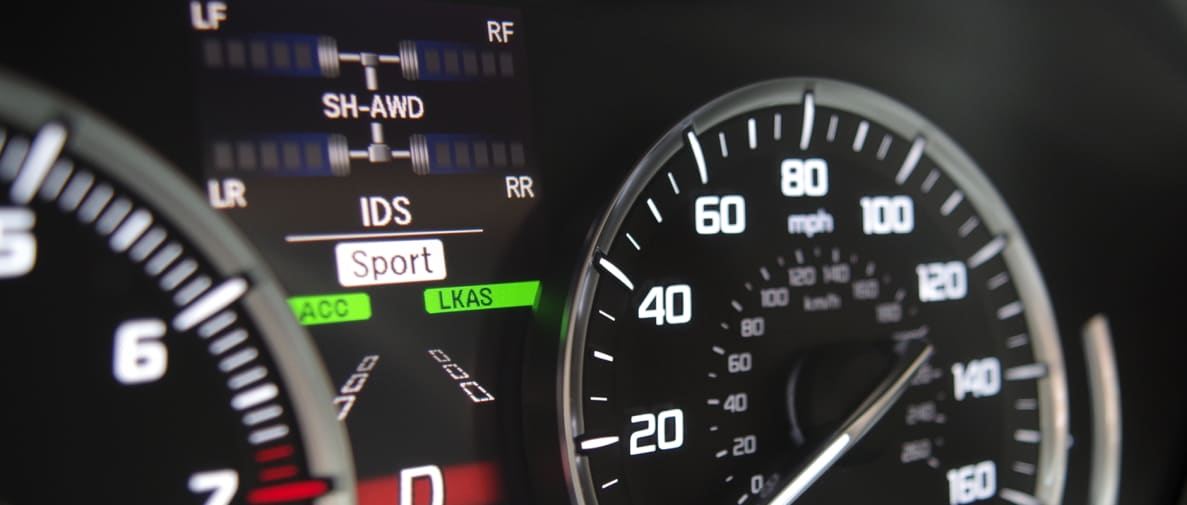It's not because I didn't think too much of the car. Quite the contrary. It's because the car didn't think too much of me.
First, some background: The TLX is Acura's all-new bread-and-butter. It replaces the outgoing TL and the TSX, and buyers will likely cross-shop the Volvo S60, Infiniti Q50, BMW 3-series, Cadillac ATS, Mercedes C-Class, and Audi A4. {{ photo_gallery name="Exterior" }}
The TLX debuts a host of new advanced driver-assistance technologies, including an advanced Lane Keep Assist (LKAS) with Road Departure Mitigation (RDM). Other cars might beep or vibrate the seat if you start to drift from your lane. But the TLX's front-facing camera translates warnings into direct action, steering the car for you, keeping between the lines and away from other vehicles. If it looks like you're about to leave the pavement, RDM will slow the car down and try to steer you back onto the blacktop.
In theory, all that safety tech means the TLX can provide some divine intervention if you decide to let Jesus take the wheel. In practice, the car couldn't stop one-upping me. {{ photo_gallery name="Tech" }}
I never came close to departing the pavement, but even with my hands at 10 and 2 and my eyes on the road, LKAS found a way to micromanage my apexes and find its own racing line. If this car were my editor, it would tweak a single word in every sentence just to exert its superiority.
(On the positive side, I got to use the phrase, "Look, Ma—no hands!" in context while showing the car off to my mother.)
It's possible to turn the system off—more on that later—and settings allow for different levels of sensitivity. But overall, my time in the TLX taught me that the machines are winning. My skills couldn't compete with what Acura's engineers had programmed.
That's a shame. Despite my apparently subpar abilities, the car was a blast to drive—once I'd turned off RDM. Technology still played a huge role here: The TLX's SH-AWD system uses torque vectoring to send more power to outside wheels in a turn to prevent understeer, and an on-screen display showed just how often it came into play. Agile Handling Assist adds a touch of braking when necessary to add stability in turns.
The car's new 290-horsepower, 3.5-liter, direct-injection V6 provided plenty of power, and a ZF 9-speed transmission—the same one that Chrysler uses—helps the TLX save weight and fuel. Acura claims the new transmission also makes for 25 percent faster shifts.
There were other things to enjoy about the car, too. The AcuraLink infotainment system got an upgrade—it's faster, and has improved voice recognition. A unique electronic gear shifter swaps a lever for buttons, and also allows for one of the best auto-start-stop systems I've ever used.

You can engage the auto-start-stop function manually by depressing the brake an inch or so further.
Instead of shutting down automatically at even the most brief pause, as most systems do, Acura's setup gives the driver the option to depress the brake pedal an additional inch or so to shut off the engine. That means auto-start-stop won't annoyingly engage in stop-and-go traffic, but it will turn off the engine to save fuel at long red lights.
All in all, driving the TLX for a week proved both comfortable and enjoyable. Of course, even when a great car is paired with a great driver, accidents can still happen. That's where tech like LKAS, RDM, Forward Collision Warning, and Adaptive Cruise Control with Low Speed Follow can really help out.
{{ photo_gallery name="Interior" }}
While I found LKAS to be too intrusive when I didn't need it, it turns out that some active safety features might not be there when you do need them.
Likely due to legal reasons—after all, the driver is responsible if a car causes an accident even if the car is driving itself—LKAS is opt-in, and the driver has to actively choose to turn it on every time he or she gets behind the wheel.
When LKAS and RDM deactivate automatically—say, under 45 mph, or when a road's lines are faded—the only indication the driver gets is a new icon in the gauge cluster. In other words, you could expect the car to be looking out for you even when it's not.
That's a shame, because active safety systems work best when they hide in the background, ready to take over at a moment's notice. No driver wants to admit to ineptitude, nobody gets into the car expecting to have an accident, and no driver wants a nanny correcting his or her every input, which is why it doesn't make any sense to force drivers to opt-in to active safety.
In a perfect world, features like RDM and LKAS would become less intrusive, yet still remain present in the far background. Until then, the Acura TLX reminds us that a car can be both fun to drive and capable of saving a human's behind—if only we let it.
Meet the tester
Keith was the Editor in Chief of Reviewed's appliance and automotive sites. His work has appeared in publications such as Wired, Car & Driver, and CityLab.
Checking our work.
Our team is here to help you buy the best stuff and love what you own. Our writers, editors, and experts obsess over the products we cover to make sure you're confident and satisfied. Have a different opinion about something we recommend? Email us and we'll compare notes.
Shoot us an email

